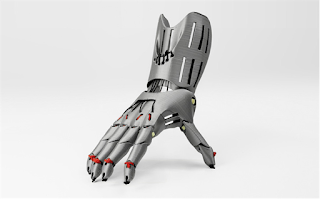By John P. Mello Jr.
Devialet, the French company that has built a reputation in the audio market for high-end wireless speakers, on Tuesday announced its newest addition: the US$3,000 Phantom Gold.
The Phantom Gold looks something like a futuristic Faberge egg, and it's priced like one, too.
That said, it has some ear-pleasing and ear-splitting specs.
Devialet has given it a power boost to 4,500 watts. That enables it to crank out sound at motorcycle levels of 108 decibels, and it does it with minimal harmonic distortion of just 0.0005 percent.
The Phantom Gold's frequency response range is beyond anything detectable by the human ear -- 14Hz at the low end and 27kHz at the high end.
"You won't be able to hear such low-frequency rumbles, but you'll feel them -- in your molars, your bowels, and in the soles of your feet," wrote Michael Calore in Wired.
Golden Gills
Devialet has re-engineered the tweeter in the latest Phantom model to improve its treble performance. It replaced the aluminum tweeter in previous models with a stiffer titanium one.
The firm also made improvements in the line's digital signal processor, and those changes are backward compatible. Owners of earlier Phantom models can get the new DSP through a firmware upgrade.
The speaker supports both wired and wireless connections, including Bluetooth, Apple's AirPlay, Ethernet, optical and WiFi.
If a listener wants to tap into the full potential of Phantom Gold, however, Bluetooth isn't the way to go, advised Rob Enderle, principal analyst at the Enderle Group.
"Given the typical compression of the sound coming out of a Bluetooth device, you most likely won't hear the full quality of this product unless you hardwire it to your streaming device," he told TechNewsWorld.
Although compact, the Phantom Gold's portability is a bit challenged by its weight -- 25 pounds -- and its need to be plugged into an electrical outlet.
Devialet has developed software to control the speaker. Its Phantom Spark app runs on Android and iOS devices, as well as Windows and Macintosh computers. It can play music from a phone, from Tidal and Spotify Connect -- and in applicable markets, from Deezer and Qobuz.
In addition, as many as 24 of the units -- which are embellished with 24-carat rose gold on the "gills" at either side of the speaker -- can be paired for a very expensive multiroom experience.
Favorable Impressions
For the most part, the trade press has reacted favorably to Phantom Gold.
"I only had a brief chance to preview Gold Phantom, but it's definitely loud and certainly clear," wrote Chris Davies for SlashGear.
"In fact," he continued, "the sample Phantom product manager Romain Salzman showed me has its amp uncapped -- it could potentially damage your hearing if pushed anywhere close to its maximum -- but what's notable is the clarity even at higher volumes."
Phantom Gold need not be taken to the max to be appreciated, maintained Dan Seifert in The Verge.
"At lower volumes, the Gold has a presence and range that exceed lesser speakers, and it excels in mid-range tones. It also has the ability to replicate high frequencies without distortion," he wrote.
"The Gold is capable of reproducing low frequencies," added Seifert, "but its small woofers don't provide the thump of a larger, dedicated subwoofer."
Best Speaker Planet's Ever Seen
Devialet has removed the brightness found in previous Phantom models, noted Ty Pendlebury in Cnet.
"Based on a short listening test the sound I heard lacked the brightness of the previous model and instead sounded open and nuanced," he wrote.
"Nick Cave's 'Red Right Hand' had the three-dimensionality I'd heard in 'proper' stereo systems and managed to untangle the knotty mass of deep vocals and bass line," Pendlebury observed.
"What we have here isn't so much a wireless speaker as it is an effort to make the very best speaker anyone on the planet has seen," wrote Tyler Lacoma in Gadget Review.
As good as Phantom Gold may be, its potential for changing the wireless speaker market is limited.
"Their price point will keep sales volumes really small, and that will likely reduce any larger impact on the market," Enderle said. "Much like Rolls Royce doesn't really drive car design, these speakers will have little impact on a market defined by products under $100, not products costing thousands."
Extreme Market
Phantom Gold is a high-end product aimed at a high-end market that's been known for extremes, said Brad Russell, an audio analyst with Parks Associates.
"The high-end audiophile market has always been about extremes," he told TechNewsWorld. "It's about owning extreme technology even if it's not discernible to most of us. It's a $10,000 turntable sitting on a block of granite to minimize vibration that wouldn't make a difference to the vast majority of us."
Phantom Gold is the third speaker in Devialet's product line, which includes the 750-watt Phantom ($1,990) and the 3,000-watt Phantom Silver ($2,390).
Devialet is taking pre-orders for Phantom Gold, which is expected to ship on Bastille Day, July 14.

